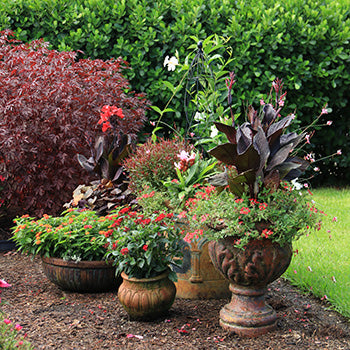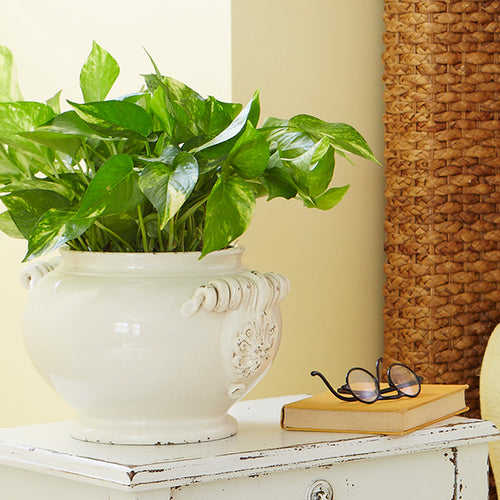By Doug Jimerson
With literally hundreds of perennial flowers to choose from, a trip to the garden center can be bewildering. Our advice? Start with the classics: beautiful, reliable, and easy-care perennials. Here are 10 that should appear in every garden.
1. Black-Eyed Susan
Commonly called Black-eyed Susan, rudbeckia is a joy to grow. It develops wave after wave of cheerful daisy-like blooms from early summer to fall. The flowers sport yellow or orange petals that surround a darker center. Most varieties grow around two feet tall and, like annual flowers, many will bloom the first year from seed. Denver Daisy and Indian Summer are two annual forms that often come back year after year. Because rudbeckias are native to the central and eastern parts of the United States, they are also naturally drought and insect resistant. Some favorite classic perennial varieties include Goldsturm (in photo), Cherokee Sunset, Prairie Sun, and fulgida.Growing Tip: Rudbeckia doesn’t always last more than a few years in one spot, but it does have a tendency to self-sow in other locations. Watch for seedlings to sprout and transplant them where you need color the most.
2. Salvia
Few perennials are as versatile as salvia, also called perennial sage. This big family of gorgeous bloomers includes varieties that are tough enough to take the cold of Minnesota and others that thrive in the heat and humidity of Florida. Plus, many salvia varieties develop deep blue flowers, a color that’s often hard to come by in the flower border (and also a coveted hue!). Some classic varieties that prefer a cooler climate include May Night (in photo), Carradona, and New Dimension. For warmer climates (zones 7 and above) choose Wild Thing, Hot Lips, or Black and Blue.
Growing Tip: As soon as your salvia stops blooming shear back plants by about one third their height. This promotes a second season of flowers later in the summer.
3. Coreopsis
Do you want a burst of sunshine in your garden? Make room for coreopsis! Its bright sunny-yellow or golden flowers are hard to miss even on a dreary day. Most coreopsis grow about 18 inches tall and produce single or double flowers. On some varieties the foliage is fine and delicate, making the flowers look like they are dancing on a lacy cushion. Like rudbeckia, coreopsis is a native prairie plant so it can take a little neglect when it comes to water and fertilizer. Some top coreopsis picks include compact-form Nana (in photo), pale yellow Moonbeam, award-winning double-flowering Early Sunrise, and pink-flowering Limerock Dream.
Growing Tip: Plant coreopsis near the front of your border so you can easily remove the fading flowers. This will extend the bloom time through the summer.
4. Sedum
Sedums are the workhorses of the perennial border. Almost impervious to heat, drought, and disease, sedums get bigger and better each year. This large perennial family includes ground-hugging varieties such as Angelina as well as taller types such as the classic three-foot-tall Autumn Joy. Most sedums bloom in late summer and fall, but they all offer handsome, fleshy foliage that looks great all season long. One of the first perennial flowers to pop up in the spring, sedums are also one of the last ones to succumb to fall’s cold temperatures. Their nectar-rich blooms are also a favorite with butterflies, bees, and other pollinators. Other great sedum choices include the pretty ground covers Tricolor and Kamtchaticum variegatum (in photo) Taller must-have sedums include Vera Jameson, Voodoo, and Neon.
Growing Tip: Because sedums spread, it’s a good idea to divide them every few years to keep them in top form. Dig the plants and use a sharp spade to separate them into smaller pieces you can share with friends.
5. Purple Coneflower
A decade ago, you didn’t have a lot of options when it came to choosing a coneflower (Echinacea) for your garden. Most varieties available looked a lot like the original native form, which has single, pink petals surrounding a dark center. But recently plant hybridizers have had a field day with this resilient perennial flower, creating new flower forms almost every year. Now, you can choose from double- and triple-flowering varieties and colors that include white, raspberry, orange, and yellow. Coneflowers generally grow 3 feet tall and bloom from early summer until fall. They’re a favorite with butterflies and make excellent cut flowers for indoor bouquets. Some favorite varieties include compact Kim’s Knee High, boldly colored Salsa Red, double-flowering Bubblegum, or surprising Sombrero Sandy Yellow.
Growing Tip: Single-flowering forms often live longer than the double or triple types. Before you buy, check the plant’s zone of hardiness to see if a particular variety will survive the winter in your garden.
6. Peony
Talk about dependable! Peonies last for years with very little help from you. In fact, there are many cases where peonies are still growing and blooming where they were planted 50 years earlier. Peonies form pretty, 3-foot tall mounds of foliage that burst into bloom in mid-spring. The plants are available in single-, double-, or semi-double forms, and flower in a wide range of colors and bi-colors. Peony blooms are also highly fragrant and make extraordinary spring bouquets for weddings or graduations. All these dependable plants require is a sunny garden spot that’s well drained—they won’t prosper in heavy, mucky soil. Choice varieties include single-flowering Krinkled White, gorgeous Coral Supreme, classic double pink Sarah Bernhardt and pink-and-cream Annamieke (in photo).
Growing Tip: Peonies require a period of cold and darkness to bloom well. That’s why they grow best from zones 4-8 where they bloom from May to June.
7. Bearded Iris
Bearded iris are one of the most sumptuous flowers in the spring garden. These spectacular perennial flowers are a snap to grow, and are prized for their eye-popping, crown-like flowers that are held aloft on tall graceful stems. They come in an almost unlimited selection of colors and bi-colors, and some varieties even put on a second show of bloom in fall. When not in bloom, bearded iris plants feature striking, sword-like foliage that stands up straight throughout the growing season. Like peonies, bearded iris requires a period of cold and darkness to bloom so are at their best in zones 3-9. Top picks include: Immortality, Again and Again, Goldkist (in photo), and Savannah Sunset.
Growing Tip: To keep your bearded iris in top form, dig and divide them every three to four years. If allow your iris to grow into one thick clump, flower production will slow.
8. Daylily
Talk about easy care! Once planted, daylilies require only a minimum of attention, yet they’ll reward you with armloads of gorgeous flowers every summer. All these reliable plants need is a sunny spot and protection from weedy intruders. Daylilies are early risers, pushing their pretty grass-like leaves up through the soil in early spring. When summer rolls around, plants develop graceful flower stems packed with buds that open into beautiful blooms. Daylilies get their name from the fact that each flower lasts for just one day. Not a worry because each plant produces a quantity of buds/blooms so there’s always color. In general, daylilies are classified as either standard or ever-blooming. As a rule, standard bloomers have bigger flowers and more colors to choose from. Ever bloomers have a more limited color palette and smaller blooms. For the biggest color show include both types in your garden. Choice varieties include ever bloomers such as Stella de Oro (in photo), Happy Returns, Buttered Popcorn, and Black-Eyed Susan. Standard bloomers include Chicago Apache, Ice Carnival, Double Passion, and Fire King. Daylilies are hardy from zones 3-9.
Growing Tip: Although daylilies prefer full sun, they will survive in partial shade. Flowering will be a bit more limited, but they will provide some much-needed color in these locations.
9. Lily
Although there are many different varieties of lilies to choose from, the two most popular types are Asiatic or Oriental. Asiatic lilies generally grow two to three feet tall and produce clusters of upward-facing, jewel-like flowers at the top of each stem. Most Asiatic lilies bloom in red, orange, yellow, white, or bicolors. They’re extraordinarily hardy and thrive in zones 3-8. Asiatic lilies spread slowly in the garden, forming bigger clumps each year. Oriental lilies tower over their Asiatic counterparts, often growing six to seven feet tall. Their flowers are often pendulous and highly fragrant. Oriental lilies also spread, although not as quickly as Asiatic lilies. They are hardy from zones 4-8. Top Asiatic lilies include: Sensation, Sunny Borneo, Buzzer, Matrix, and Golden Joy (in photo). Some top Oriental lilies include: Starfighter, Love Story, Farolito, and Show Winner.
Growing Tip: Both types of lilies are best divided in the early fall. Dig the entire clump, separate the bulbs, and replant, spacing them 18 to 24 inches apart.
10. Hosta
Having a shady backyard doesn’t mean you can’t have a colorful garden. Hostas thrive in the shade, and are available in an almost limitless selection of sizes, shapes, and colors. In fact, there are so many hosta options to choose from that you can create an entire garden with just this one species. Hostas prefer a rich, slightly moist soil, but are tough enough to endure less-than-ideal conditions. Their biggest challenges are deer and slugs, two creatures that find hosta foliage especially tasty. Hostas also develop gorgeous flower spikes in pink, lavender, or white. The flowers of some varieties are also fragrant. Some choice large hosta varieties (some can get 4 feet tall) include Sagae, Frances Williams, Sum and Substance, Francee, and Patriot. Medium and small varieties include: Fire & Ice, Paul’s Glory (in photo), Guacamole, June, and Blue Mouse Ears. Most are hardy from zones 3-9.
Growing Tip: If you see holes in the leaves of your hostas, you probably have slugs nearby. These creatures dine at night so you won’t see them destroying your plants during the day. To combat them, use an organic slug bait or place halved orange or grapefruit pieces around your plants. At night the slugs will be attracted to the fruit, which you can then remove, slugs and all.
Want to Buy Costa Farms Perennials?
Check out this list of our retailer partners to find a store -- either locally or online -- that offers Costa Farms plants.
Perennial Gardening Questions?
We love to talk to other gardeners. Email us your questions and we'll have one of our experts get back to you!


























